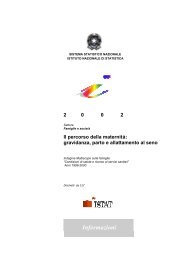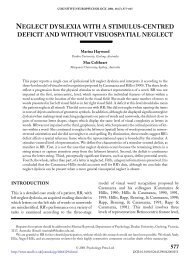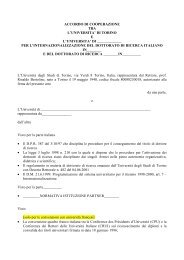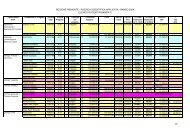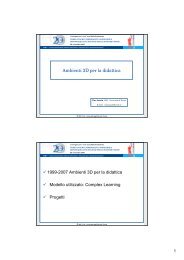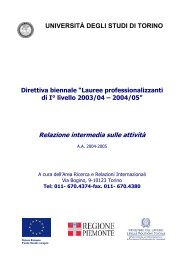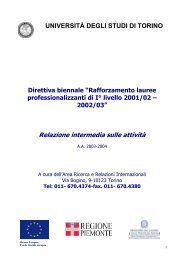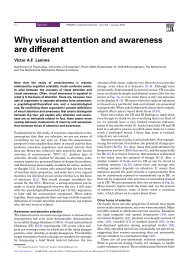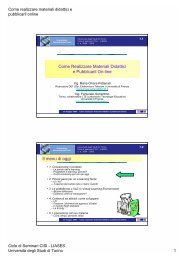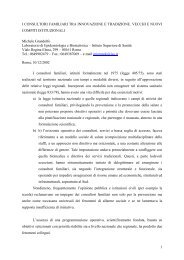Spatial hemineglect in humans - Cisi
Spatial hemineglect in humans - Cisi
Spatial hemineglect in humans - Cisi
You also want an ePaper? Increase the reach of your titles
YUMPU automatically turns print PDFs into web optimized ePapers that Google loves.
G. Kerkho€ / Progress <strong>in</strong> Neurobiology 63 (2001) 1±27 17<br />
1991; Harvey et al., 1995; Barton et al., 1998) <strong>in</strong> leftsided<br />
visual neglect.<br />
13.3. Representational theories<br />
Bisiach and colleagues formulated a model of topological<br />
space representation (Bisiach and Luzzatti,<br />
1978; Bisiach et al., 1981). This model assumes that<br />
every sensory event has a representation. This mental<br />
representation can be activated either through sensory<br />
a€erences or by memory engrams. More particularly,<br />
the model assumes that this topological space is not<br />
coded veridically <strong>in</strong> neglect patients. Their left side of<br />
representational space is enlarged whereas the right<br />
side is constricted compared with normal subjects<br />
(Bisiach et al., 1996). In contrast to the premotor theory<br />
by Rizzolatti (see below), this model does not<br />
detail where and how this topological space representation<br />
is created. This model is compatible with the<br />
recent evidence <strong>in</strong> patients with a unilateral temporal<br />
lobe removal (Hornak et al., 1997) and experimentally<br />
<strong>in</strong>duced neglect <strong>in</strong> monkeys (Ga€an and Hornak,<br />
1997; see review <strong>in</strong> Ga€an and Hornak, 1999). Accord<strong>in</strong>g<br />
to these ®nd<strong>in</strong>gs, widespread cortical areas <strong>in</strong> each<br />
cerebral hemisphere <strong>in</strong>teract with each other <strong>in</strong> memory<br />
retrieval to produce a ret<strong>in</strong>otopically organized<br />
representation of the contralateral visual world.<br />
Lesion<strong>in</strong>g of the temporal cortex Ð which is often but<br />
probably not always <strong>in</strong>cluded <strong>in</strong> neglect patients Ð<br />
would then produce a hemi-amnesia for th<strong>in</strong>gs occurr<strong>in</strong>g<br />
<strong>in</strong> the contralateral hemispace. This is compatible<br />
with Bisiach's theory. One possible problem with this<br />
theory is the explanation of the hemispheric asymmetry<br />
<strong>in</strong> neglect.<br />
A more physiologically oriented theory of neglect<br />
states that space representation is enabled by the activity<br />
of premotor cortical structures (Rizzolatti et al.,<br />
1997) which are l<strong>in</strong>ked closely to attention (Sheliga et<br />
al., 1995). Accord<strong>in</strong>g to this view, space is motorically<br />
coded by actions towards positions <strong>in</strong> certa<strong>in</strong> space<br />
sectors (cf. Section 9.2). A lesion to these specialized<br />
premotor structures would then cause a neural representational<br />
de®cit lead<strong>in</strong>g to neglect <strong>in</strong> a certa<strong>in</strong><br />
space sector. S<strong>in</strong>ce attention and movement towards<br />
targets <strong>in</strong> contralateral space are <strong>in</strong>tricately connected,<br />
this theory would encompass attentional and motor<br />
neglect phenomena as well. Moreover, it is not <strong>in</strong>compatible<br />
with the more cognitive representational<br />
account of Bisiach, although it di€ers from the latter<br />
<strong>in</strong> that it does not hypothesize one topological spatial<br />
map but rather a number of decentrally organized<br />
(Rizzolatti et al., 1983) space maps, which relate to the<br />
di€erent motor e€ectors (Rizzolatti et al., 1997).<br />
13.4. Transformational theories<br />
These theories assume that the transformation of<br />
sensory (<strong>in</strong>put) <strong>in</strong>formation <strong>in</strong>to motor (output)<br />
action, which is necessary due to the di€erent reference<br />
frames or `format' <strong>in</strong> which sensory and motor <strong>in</strong>formations<br />
are coded <strong>in</strong> the bra<strong>in</strong> is impaired <strong>in</strong> spatial<br />
neglect (Jeannerod and Biguer, 1987, 1989). S<strong>in</strong>ce such<br />
coord<strong>in</strong>ate transformations are likely to be computed<br />
<strong>in</strong> parietal cortex (Andersen, 1995; Andersen et al.,<br />
1997) a parietal lesion caus<strong>in</strong>g neglect might impair<br />
such transformations. In a variant of this orig<strong>in</strong>al<br />
account both Vallar (1997) and Karnath (1997) have<br />
proposed that this coord<strong>in</strong>ate transformation seems to<br />
work with a consistent error, i.e. the straight ahead<br />
direction is not coded as 08 but as +158 to +208 ipsilesionally,<br />
thus caus<strong>in</strong>g the observed shift <strong>in</strong> the subjective<br />
straight ahead and the deviated visual and<br />
tactile exploratory patterns (Fig. 2A, B). The two theories<br />
di€er <strong>in</strong> their assumptions regard<strong>in</strong>g the type of<br />
spatial error. Vallar postulates a translation of the egocentric<br />
midsagittal representation <strong>in</strong> relation to the<br />
trunk midl<strong>in</strong>e while Karnath assumes a rotation<br />
around the subject's body midl<strong>in</strong>e (see Fig. 9).<br />
While the assumptions of both models (at least <strong>in</strong><br />
front space) would ®t the observed data on egocentric<br />
de®cits <strong>in</strong> neglect, it rema<strong>in</strong>s unclear exactly how this<br />
``error term'' <strong>in</strong> the coord<strong>in</strong>ate transformation models<br />
is created and on which physiological grounds it is<br />
based. The transformational theories do not deal with<br />
allocentric and object-centered neglect and do not<br />
attempt to expla<strong>in</strong> these phenomena <strong>in</strong> their framework.<br />
Fig. 9. Schematic demonstration of translation of the auditory subjective<br />
straight ahead (SSA, left ®gure) and rotation of the auditory<br />
SSA (right ®gure) <strong>in</strong> leftsided neglect. The translational results<br />
(redrawn based on data by Vallar et al., 1995a) <strong>in</strong>dicate a similar<br />
shift of the SSA <strong>in</strong> front and back space towards the right, ipsilesional<br />
side by 15±208. In contrast, the rotational hypothesis is based<br />
on a rightsided shift of the SSA <strong>in</strong> front space and a correspond<strong>in</strong>g<br />
leftward shift of the SSA <strong>in</strong> back space. Note that these results are<br />
not due to peripheral hear<strong>in</strong>g de®cits s<strong>in</strong>ce pure tone audiometry<br />
reveals normal peripheral hear<strong>in</strong>g functions <strong>in</strong> these patients.



